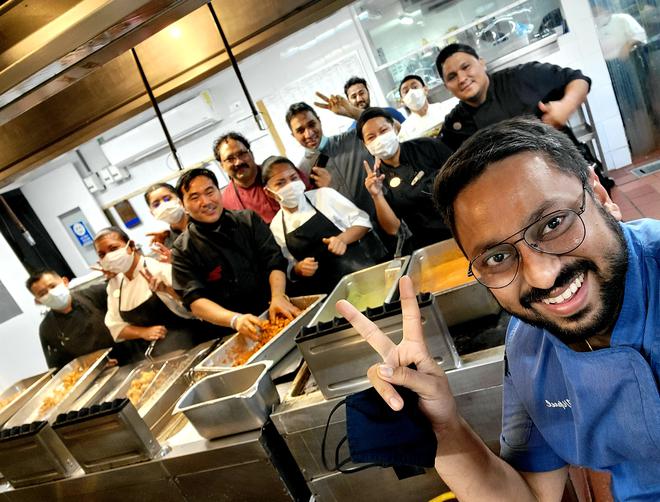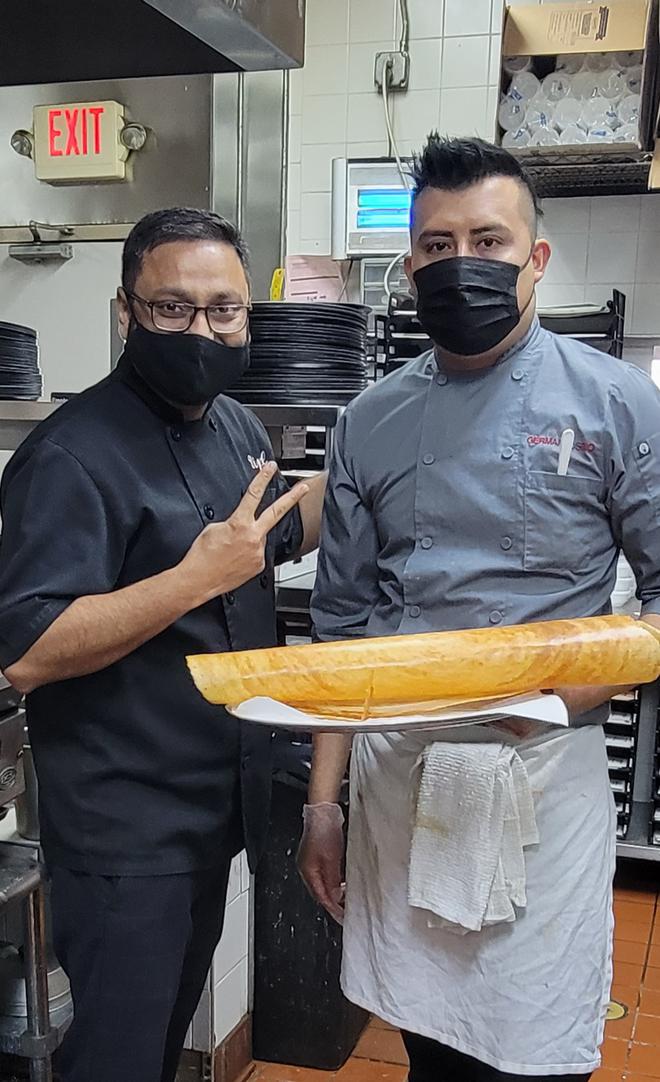The signage at the door proclaims MTR 1924. There is vintage memorabilia on the walls inside, but the serpentine queue of diners waiting to get in is only partly interested in history. Instead, it is the lure of “authentic” bisibele and khaara bath, of “strong” filter coffee — made from a blend that is a closely-guarded family secret — and hot dosas that have hundreds of families driving from near and far to Harrow, London, where Bengaluru’s iconic, almost 100-year-old restaurant, MTR, has just opened.
It’s late January still, only a few days since the outpost opened. Among the potential diners that evening are my friends Namrata, a Delhi girl, and her husband, Sanjeev, from Chennai, who stand awaiting their turn for about 45 minutes, before giving up. “The average wait time was one-and-half hours and a shopkeeper in the vicinity told us that people were coming from as far as Leeds, Brighton and Birmingham to eat,” Namrata later says.

When I narrate this to Hemamalini Maiya, third generation owner of MTR, she chuckles, thrilled, but cautions that “it will all settle down”, as the initial “buzz” inevitably does. Regardless of the reception, I am calling Maiya not just to congratulate her, but to quiz her on a crucial aspect of the global business that gets curiously overlooked. How do the increasing number of regional Indian restaurants opening internationally — mostly to better profit margins than the ones back home — navigate labour challenges?
Easing restrictions
Traditionally, in the West, labour has been more expensive and tough to come by than in India. And now in a world upended by the pandemic, labour shortage has become Neo Liberalism’s big crisis.

In London and New York, Melbourne and Paris, as traditional supply of restaurant staff has dwindled post pandemic — with thousands of hospitality workers exiting the harsh sector, chucking long hours of work, low wages, and demanding customers — restaurants are clearly having trouble coping. Some have shut, some “forced to compromise by closing two days a week”, as chef Sameer Taneja of the Michelin-starred Benares in London laments. Several have shortened their menus, while still others are exhorting customers to serve themselves to help out the beleaguered staff.
Spanking new openings, however, are reporting housefuls every day, from Sona (Priyanka Chopra’s New York restaurant), MTR and Chourangi in London (the latter being Anjan Chatterjee’s Calcutta special eatery), to Très Ind in Dubai — not new but newly anointed as the number four swish space on the prestigious World’s 50 Best in MENA (Middle East North Africa). What is the reality behind the scenes? Are they finding it tougher to get staff, or is the new world order seeing (or expecting) easier hires from India, as countries with shortages make work visas easier?

“Labour has always been a complex issue, with every market functioning differently. It also depends on the format of the restaurant,” says restaurateur M Mahadevan, who has in the past opened his brand Hot Breads in the US, Paris and Dubai, apart from investing in popular brands like Saravana Bhavan and Kailash Parbat in multiple locations. Indian Accent’s Rohit Khattar points out, “There are five million fewer people working than before the pandemic began, and three million fewer looking for work [in the US],” sharing how difficult it has been to get staff for the restaurant’s New York outpost. The figures that he quotes are from a New York Times article addressing the labour crisis in America.
In the UK, post Brexit, labour shortages are equally dire at restaurants. However, there may be a sliver of hope for Indians. “London was not as much of a challenge as we feared,” Maiya tells me candidly. “Our local partner had been ready to open quite some time ago but he deliberately waited till after Brexit, judging that bringing chefs from India would be a little better then. He was proved right,” she says, alluding to the recent lowering of financial commitments required from employers who want to hire foreign staff in the UK. While MTR London hired two to three key cooks, the rest are new local staff put through intensive training.

Staying local
In the UK, traditionally, top Indian restaurants have always functioned with a multicultural staff, both in the kitchen and front of the house. “While the curry houses sought to hire Indian, Bangladeshi or Pakistani ethnicities, when trendier, high-end restaurants emerged, they consciously wanted to cultivate a more multicultural environ because they wanted to attract a cosmopolitan, higher-paying European crowd,” says Prashant Issar, who spent a decade in London leading some of Camellia Panjabi’s most prestigious restaurants, including the glamorous Amaya.
According to Issar, restaurants like Panjabi’s had strong systems and processes so that anyone from any ethnicity could work there, including in the kitchen. “If you are setting up a restaurant abroad, you must learn to use local staff. The executive chef must be able to break down every recipe into clear cooking processes so that even foreign staff can cook various elements of every dish,” he says, adding that even specialised jobs like that of a tandoor chef (usually hired from India) can be done by any one trained to use a gas tandoor in western set ups.

Almost all top restaurants follow this practice now. “We are lucky to have a core kitchen team that has been with us for a long time, but we are also now recruiting local team members and training them,” says Sriram Aylur of Quilon, the only South Indian Michelin-starred restaurant in London. The service staff at upscale Indian restaurants have always been international, and multitaskers (Issar talks about how a single bartender looked after service, procurement, wine lists, and was trained to talk about lassi and rasam to guests, unlike in India where at least three different people would have done these tasks). Now, there is a gap in the market for all these positions, at all levels. And this kind of a shortage of labour is complex and “not going away any time soon”, says Aylur.
Students to the rescue
As the world, and restaurants, reopen and newer ones put down roots in global cities with the greatest potential for “revenge dining” and profit, demand for skilled Indian restaurant labour is at an all time high. “The demand has shot up everywhere — in the UK, Canada, Australia and the Middle-East,” says chef Nitin Pal Singh, a recruiter, who has been training and facilitating the hiring of Indian chefs and food services staff to restaurants globally over the last eight years. Since all levels of restaurant workers are in short supply globally, many countries have eased or are in the process of easing restrictions on hiring foreign labour.
A few markets like the UK and even Canadian provinces are opening up chef categories for work and immigration. “Bakers as a category opened up a few years ago in Canada, and there has been an exodus of bakery professionals there from India. They are employed not just in Indian restaurants but all sorts of restaurants since baking is strictly dependent on recipes,” Singh says.
An interesting category of temporary work force that has emerged is Indian students — many from well-to-do homes, not necessarily studying hospitality in international universities. Recruiters say that many of them take up short term cooking courses at home so that once they go abroad, they can fend for themselves and find employment during their permitted work hours.
“In the US, Indian restaurateurs must know how to work with temporary staff,” says Vipul Gupta of Mogul Catering, North America’s biggest and oldest Indian food company. Gupta, in the process of setting up a restaurant in New Jersey, routinely uses students and part-time workers for his extensive catering and plans to use them at the restaurant too. “In India, hiring is pretty straightforward, but in the US, the system is different. Many people in this industry work part-time, so shifts have to factor that in, and you must have your staff strength accordingly,” adds the veteran chef who worked with ITC hotels and Hyatt in earlier stints. Well-known for his traditional cuisine, he contends that anyone can be taught how to cook high-quality Indian food. “My Mexican chef makes softer idlis than any chef in Delhi!” he concludes.







